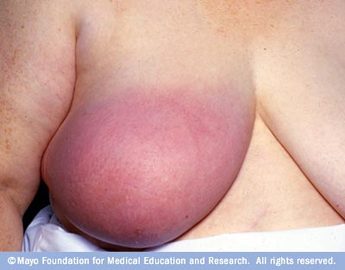What is Breast Cancer?

Although it can also affect men, breast cancer occurs predominately and is the most common type of cancer among women. It is a malignant tumor (a group of cancer cells) that originates from the breast tissue and is commonly found in the inner lining of the milk ducts.
Therapy is based upon the severity of the disease – the severity, tumor size, growth rate, and other significant characteristics. Treatment of breast cancer usually includes surgical procedures, chemotherapy, radiation, and immunotherapy. In breast cancer, surgical removal of the tumor is in itself, the most beneficial procedure and can cure or lengthen the survival rate of an individual. Chemotherapy is often given in addition to surgery.
This type of cancer covers about 22.9% of all cancers worldwide in women. Its occurrence is nearly 100 times more common in women than in men. The outcome of the disease depends upon the type of cancer, stage and treatment regimen. Given the proper treatment, the prognosis and outcome is good.
Diagnosing Breast Cancer

Common signs of breast cancer may be a painless lump or mass found in the breast or armpit. There may also be changes in color, size, shape and feel of the nipple and breast. You may notice redness, dimpling, or wrinkling that looks like that of an orange’s skin (in medical terms, this is called peau d’orange). Abnormal nipple discharge may also be noted – it may be bloody, yellow like pus, or clear fluid. You must report to your physician at once if you notice one or more of these signs and symptoms.
Diagnosing the disease can be done through screening mammography and/or breast self-examination (BSE). Starting at the age of 20, women should begin doing BSE. This is done monthly. Mammograms are very good screening tools for women aged 40 and older, and they should continue to do screening annually as long as they are in good health. When doing both methods, make sure to review the results with your physician and report immediately if there are any significant breast changes.
How to Stage Breast Cancer

A physician is the one who determines the severity of breast cancer through a series of examinations. Severity is based on the size of the malignant tumor and whether the cancer cells have spread (metastasized) to nearby tissues and organs. Using these, the physician assigns a numeral, I to IV, which describes the specific severity of breast cancer:
Stage 0 (Carcinoma in situ): The early stage in which the cancer cells are localized only within the breast without spreading to the nearby lymph nodes.
Stage I (Early stage invasive): The tumor is no larger than 2 cm and has not yet spread to the lymph nodes or outside the breast.
Stage IIA: Tumor is less than 2 cm but has begun to spread up to three auxiliary underarm lymph nodes, or the tumor is bigger than 2 cm but no larger than 5 cm without any lymph node involvement.
Stage IIB: Tumor has grown between 2 and 5 cm with involvement of lymph nodes, or tumor size is greater than 5 cm but has not spread to nearby lymph nodes.
Stage IIIA: Tumor is less than 5 cm and has spread up to nine auxiliary lymph nodes, or the tumor is at any size with lymph node involvement that adheres to one another or to a surrounding tissue.
Stage IIIB: The cancer cells have spread to nearby tissues such as the skin, pectoral muscles, ribs, chest wall, or lymph nodes found in the chest wall or above the collar bone.
Stage IV (End-stage breast cancer): Cancer cells have spread to other organs such as bones, lungs, liver, brain, or other lymph nodes.
Preventing Breast Cancer
If you have a strong, positive familial history for breast cancer, this is relevant to your diagnosis. Gather information about other family members like aunts and nieces as well. A thorough diagnostic workup, treatment regimen and possibly genetic testing may be necessary for you and other members of the family.
There is no guaranteed method to prevent cancer, but it is always helpful to review significant risk factors. Regular exercise, maintaining a healthy body weight, eating a healthy diet, avoiding excessive alcohol intake and cigarette smoking are some of the most helpful ways for you to prevent this fatal disease.
Comments
Most Recent Articles
-
About Types Of Cancer That Affect Men
There are cancer types that are common in men. These types of cancer are reported to happen more in men than any other types. For some obvious and not-so-obvious reasons, men are just prone ...
-
What Are the Symptoms Of Liver Cancer?
Hepatocellular carcinoma or liver cancer as it is commonly known arises from the liver. The human liver is composed of a number of different cell types such as bile ducts and blood vessels b...
-
How To Protect Yourself From Spirilla
Bacteria, germs, pathogens, microbes, viruses, and parasites are collectively known as microorganisms. These minute living organisms cause serious waterborne diseases that may claim the live...
-
What Is Bone Cancer?
Our body is composed of 206 bones from head to toes and when abused may cause bone cancer. Bone cancer is a disease that eats-up the components of the bone inside the body. In may start from...
-
What Are The Causes Of Blackleg
Sheep are the most common target of blackleg disease, also known as Clostridium chauvoei. The blackleg disease was derived from the infected part of the sheep which is usually the leg, ...
-
Are Periodontal Diseases Avoidable?
Periodontal diseases or gum diseases are common mouth problems to many. The disease extends from a simple gum irritation to a more serious gum disease resulting in a great damage to soft tis...
-
How To Treat Neglected Tropical Diseases
Neglected tropical Diseases (NTD) are a group of bacterial and parasitic infections which are affecting 1 billion people. Studies show that these infections persist exclusively in the poores...
-
the Most Common Zoonotic Disease
You may not be familiar or would have never heard the term Zoonotic diseases, but yes they exist. These are infectious diseases transmitted from animals whether wild or domesticated, to huma...
-
what is psittacosis?
What is psittacosis? It is one of the zoonotic infectious diseases caused by a bacterium called Chlamydophila Psittaci. Psittacosis is also called parrot fever or chlamydiosis. The name of t...
-
Leadng Causes Of Cancer in Men
Cancer knows no gender. Even the bravest of men can be affected by men cancer. Cancer can come to any man in many different forms. Certain types of cancer may show some signs of its possible...
-
What Is Bladder Cancer?
The urinary bladder plays a vital role in the human body and its functions. The bladder is a muscular sac in the pelvis where fluid or urine from the kidneys is stored. During urination the ...
-
What You Must Know About Medical Diseases
Most people have experienced some kind of a disease before or at least at one point in life. And if you can still remember the last time you suffered from a disease and felt ill, you will re...
-
How To Prevent Psoriasis Skin Diseases
You might have heard of this disease before but have less or no idea of what this is all about. If you are one of those who are experiencing this type of skin disease or just want to know mo...
-
The Most Deadly Sex Disease
Sex diseases are commonly known as sexually transmitted diseases and are popularly known as STDs. Its older term was venereal disease or VD. As it is clearly pointed out by the name, sexual...
-
How Does Lung Cancer Manifested in the Body
In the United States, lung cancer is the secondary major public health problem. Lung cancer often undetected and most lung cancer manifested patient only lives 5 years after their diagn...